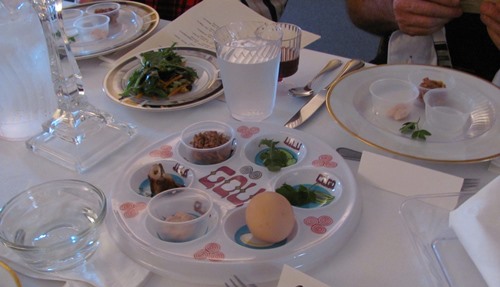The Christian Seder Meal as Sacrament and Precursor to the Fulfillment of Romans 11
The Holy Spirit and the Sacraments
But let me expand this into a specifically pneumatological (Holy Spirit) understanding of the sacraments. Modern historical scholarship has revealed that John did not invent water baptism out of the blue. Rather his baptism was a continuity and development of a ritual developed in the inter-testament period for the acceptance into Judaism of female converts. The Old Testament is clear that male converts are to be circumcised, but silent on female converts. The inter-testament rabbis chose water immersion as a natural symbol to cleanse the convert of Paganism and its sins. Similarly, the Christian Eucharist had anterior forms in the Jewish religious fellowship meal, the Berakka, where the food was blessed and special thanksgiving was given over the wine and bread. [3]
It seems these ritual developments were inspired by the Holy Spirit to prepare the way for the salvific importance of Christian Baptism and the Eucharist. It is also probable that at every step they were grace giving and already sacramentally effective, as the Luke scripture affirms of John’s water baptism.
 Evidence from Church history
Evidence from Church history
In studying revivals I encountered revivals at the edge of the modern era that were unlike anything in contemporary times. These were The Scottish communion revivals of the 18th and 19th Centuries. The most famous ones were the revivals in Cambusland, Scotland in 1740 and the Cane Ridge, Tennessee in 1801 which triggered the Second Great Awakening in America. In these revivals the people met in fields, with their tents lining a field where preaching went on for days, culminating in a communion service. They were vastly successful in bringing thousands to salvation, and in America established the “camp meeting” tradition. This has continued to encourage and refresh American Christianity to this day.
I have suggested that part of the success of these revivals was that they had, under the guidance of the Holy Spirit, unintentionally recreated the Jewish feast of Booths. All the essential elements were there. The people lived in tents, (and thus abandoned their principal emblem of social position) shared food, and heard the scriptures preached with the intention of coming to repentance. To the graces of the Feast of Booth were added the Christian graces of the Eucharist. It was spiritual dynamite![4]
The present Jewish/Christian reconciliation
People born in the last decades have little experience of the strong anti-Semitism that was part of Christian culture, both here and over-seas, and which had its origins in the Jewish Christian divide of the 2nd Century. [5] Jews emigrating from Europe to the United States in the 1920s and 1940s mostly shrugged it off, as the social snubs, nasty jokes, or skipped promotions were not to be compared the Russian pogroms or the beastly acts of Nazism. Personally, I recall that even as a devout Catholic boy in the 1950’s, I participated in anti-Semitic jokes and anecdotes about the “miserly” Jews.
Category: Ministry, Summer 2016


